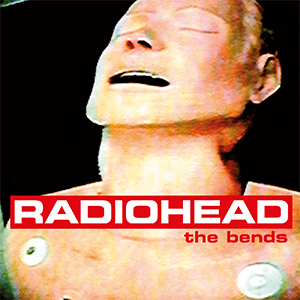
I spent this week with Radiohead’s second album “The Bends” from 1995. This album came out when my senior year of high school was coming to a close. It seems like I heard the song “High and Dry” a bit, but I don’t recall being too aware of this album until the following year. Several of the songs, especially “Just” and “Fake Plastic Trees” became part of the regular soundtrack of my life. It wasn’t so much my choice, though I did love the song. Both Mtv and my friends played “Fake Plastic Trees” with some frequency. Somehow, I managed to not get to know much of this album until this week.
It’s funny how you don’t realize how “of its time” some recordings can be until you listen to them a couple decades later. This album is definitely within the 90s guitar alt-rock genre. Listening to this album made me really realize how influential the Pixies had been on the sound of 90s alternative. I found this especially noticeable in the way the bass is used in these songs. There will be louder sections with drums, guitars, bass, vocals, etc.. and then these will pull back for quieter sections with crispy bass guitar grooves. Anyway…
The song I most know from this album is undoubtedly “Fake Plastic Trees”. In the video, you’ll see singer Thom Yorke riding around the grocery store in the shopping cart. I guess this was just a thing in the 90s, as Jarvis Cocker did it the year before in Pulp’s video for “Common People.” I know there were others, but all I can remember now is an early publicity shot of Marilyn Manson.
Thom Yorke’s quietly strummed acoustic guitar opens the song. Yorke sings sonorously, wet with deep reverb. The lyrics deal with capitalism and artificiality in contemporary society and culture. A sense of humor runs through the lyrics, while they express an emotional mix of disillusionment, emptiness and longing.
A green plastic watering can
For a fake Chinese rubber plant
In the fake plastic earth
That she bought from a rubber man
In a town full of rubber plans
To get rid of itself
The first chorus repeats the line “It wears her out.” This gets modified to “It wears him out.” in the second chorus and finally “It wears me out” for the third and final verse. I like this use of the chorus as a refrain for verses, altered slightly to match the subject of the verse.
The personal turn the songs takes for the final verse, comes even more raw at the end. Yorke closes “Fake Plastic Trees” wistfully singing “If I could be who you wanted all the time.” This reminds me of the chorus “You’re so fuckin’ special; I wish I was special” in their song “Creep.” He gritted his teeth to sardonically deliver that line in the earlier song, spitting it out more as an insult. But in “Fake Plastic Trees” the line comes out as a painful apology for not being enough.
I came to really enjoy the song “Bones,” which follows “Fake Plastic Trees” on the album. It’s probably the most rock n’ roll track. I really like the use of deep tremolo on the overdriven guitar. With each strum in each verse, they drop the speed of the effect as the chord naturally fades out. They disable the effect for chorus. Still, I’ve found with the Rolling Stones and now Radiohead that I really enjoy guitars through tremolo and rotating speaker. It’s particularly exciting when the rhythm of the strumming is in a fight against the tremolo. This can be heard in “Bones” just before each chorus when they they have the speed up.
My favorite track on the album remains “Just.” The song opens with a particularly 90s acoustic guitar riff, much like we would hear later the same year from Oasis. This style of rhythmic strumming was heard a lot during the decade, probably coming from the Pixies and Boston by way of Nirvana. Radiohead crafted an excellent song here, but what really gets me is the bridge starting halfway into the song. At about 2:28, we hear electric guitar draw the song back in with string noise through tremolo! I would argue that the bridge of “Just” unusually includes another chorus. This comes to a tense climax when Greenwood’s frantically picked ascending lead guitar peaks.. holding a distorted note threatened by impending feedback. The other instruments pull back giving a floating weightless feeling to the moment. Just before feedback overrides the note, Greenwood slides it back and mutes the guitar. A clean guitar brings back the beat of the song with staccato pronunciations. The the band slams us with one last chorus before closing the song by sudden cutting out.





